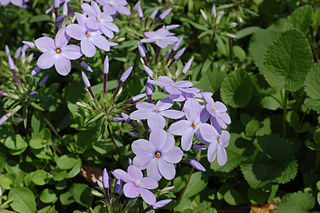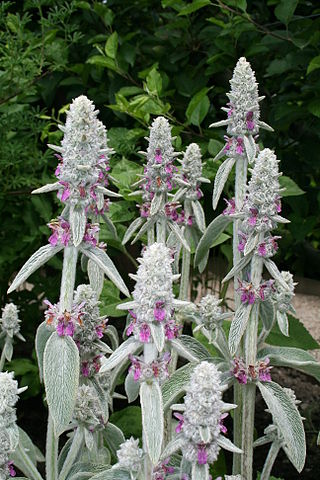
Phlox is a genus of 68 species of perennial and annual plants in the family Polemoniaceae. They are found mostly in North America in diverse habitats from alpine tundra to open woodland and prairie. Some flower in spring, others in summer and fall. Flowers may be pale blue, violet, pink, bright red, or white. Many are fragrant.

Phlox stolonifera is a species of flowering plant in the family Polemoniaceae. It is a perennial herbaceous plant that is native to the eastern United States. It occurs in woodlands and stream banks in the vicinity of the Appalachian Mountains from Pennsylvania south to northern Georgia. Naturalized populations occur as far north as Québec, Canada.

Cornus canadensis is a species of flowering plant in the dogwood family Cornaceae, native to eastern Asia and North America. Common names include Canadian dwarf cornel, Canadian bunchberry, quatre-temps, crackerberry, and creeping dogwood. Unlike its relatives, which are for the most part substantial trees and shrubs, C. canadensis is a creeping, rhizomatous perennial growing to about 20 centimetres tall.

Stachys byzantina, the lamb's-ear or woolly hedgenettle, is a species of flowering plant in the mint family Lamiaceae, native to Armenia, Iran, and Turkey. It is cultivated throughout much of the temperate world as an ornamental plant, and is naturalised in some locations as an escapee from gardens. Plants are very often found under the synonym Stachys lanata or Stachys olympica.

Phlox pilosa, the downy phlox or prairie phlox, is an herbaceous plant in the family Polemoniaceae. It is native to eastern North America, where it is found in open areas such as prairies and woodlands.
This page provides a glossary of plant morphology. Botanists and other biologists who study plant morphology use a number of different terms to classify and identify plant organs and parts that can be observed using no more than a handheld magnifying lens. This page provides help in understanding the numerous other pages describing plants by their various taxa. The accompanying page—Plant morphology—provides an overview of the science of the external form of plants. There is also an alphabetical list: Glossary of botanical terms. In contrast, this page deals with botanical terms in a systematic manner, with some illustrations, and organized by plant anatomy and function in plant physiology.

Mandevilla sanderi, the Brazilian jasmine, is a vine belonging to the genus Mandevilla. Grown as an ornamental plant, the species is endemic to the State of Rio de Janeiro in Brazil. It is a rapidly growing, creeping, perennial plant, pruning shoots about 60 cm per year.

Gilia capitata is a species of flowering plant in the phlox family known by the common names blue-thimble-flower, bluehead gilia, blue field gilia, and globe gilia.

Ipomopsis tenuifolia is a species of flowering plant in the phlox family known by the common name slenderleaf skyrocket, or slenderleaf ipomopsis. It is native to Baja California with its range extending just into California and Arizona, where it is a plant of the deserts and chaparral. This is a perennial herb taking the form of a neat clump of slender, erect multibranched stems reaching a maximum height near 40 centimeters. The leaves are narrow to threadlike and occur all along the stem branches. The inflorescences appear at or near the tips of the branches and each holds one to seven bright scarlet flowers. Each flower is a tube 1 to 2 centimeters long opening into a flat or bell-shaped corolla with squared or toothed lobes. The five stamens and one style protrude far out of the mouth of the flower. The stamens have white to purple anthers and the style has three whitish stigmas.

Ipomopsis tenuituba, also known as slendertube skyrocket and slendertube ipomopsis, is a species of flowering plant in the phlox family Polemoniaceae. It is native to much of the western United States from California to Colorado, where it is found on rocky mountain slopes.

Phlox nivalis is a species of flowering plant in the Polemoniaceae family, it is commonly known as the trailing phlox, but other common names include Pineland phlox, Pine phlox, and sweet trailing. It is native to the southeastern states, along with Texas, Utah, and Michigan.

Correa pulchella, commonly known as the salmon correa, is a species of small prostrate to erect shrub that is endemic to South Australia. It has glabrous, leathery, narrow oblong to broadly egg-shaped leaves and pendulous, cylindrical, pink to red or orange flowers arranged singly on short side branches.
Eriastrum virgatum is a species of flowering plant in the phlox family known by the common name wand woollystar. It is endemic to California, where it is known the coastline and coastal mountain ranges of Monterey and San Benito Counties. It grows in chaparral and coastal and inland scrub habitat. It is an annual herb producing a thin, usually woolly stem up to about 40 centimeters tall. The leaves are narrow and thick, up to 5 centimeters long, and sometimes divided into two narrow lobes. The inflorescence is a woolly cluster of narrow, leaflike bracts laced with webby fibers. The flowers have yellow throats and bright blue corollas with lobes up to a centimeter long.

Phlox speciosa is a species of phlox known by the common name showy phlox. It is native to western North America from British Columbia to Arizona and New Mexico, where it occurs in sagebrush, pine woodlands, and mountain forests.

Spigelia gentianoides is a rare species of flowering plant in the Loganiaceae known by the common names purpleflower pinkroot and gentian pinkroot. It is native to Alabama and Florida in the United States, where a few small populations remain. It is threatened by the loss and degradation of its habitat, and is a federally listed endangered species of the United States.

Asplenium × trudellii, commonly known as Trudell's spleenwort, is a rare hybrid fern of the eastern United States, first described in 1925. It is formed by the crossing of mountain spleenwort (A. montanum) with lobed spleenwort (A. pinnatifidum). Trudell's spleenwort is intermediate in form between its two parents, and is generally found near them, growing on exposed outcrops of acidic rock. While A. × trudellii is triploid and sterile, there is some evidence that it can occasionally reproduce apogamously.
Phlox buckleyi, common name swordleaf phlox or shale-barren phlox, is a plant species native to Virginia and West Virginia. It grows in open woodlands, primarily on hillsides derived from shale. The first known specimen was first collected in 1838 but not described as a species until 1930.

Karomia speciosa is an African deciduous large shrub or bushy tree up to 7 m, and relocated to the family Lamiaceae from Verbenaceae. It is one of 9 species in the genus Karomia, a genus containing species previously classified in Holmskioldia, and is closely related to Clerodendrum. The only remaining species in the genus is Holmskioldia sanguinea, occurring in the foothills of the Himalayas.

Aliciella latifolia, also known as broad-leaved gilia, is a foul smelling annual plant in the Phlox family (Polemoniaceae) found in deserts of the southwestern United States.

Castilleja kraliana, is a species of flowering plant in the family Orobanchaceae known by the common names Cahaba paintbrush or Cahaba Indian paintbrush.


















